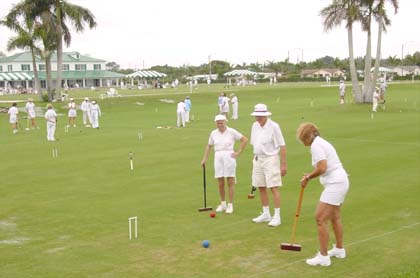

|
Back to |
| The Front Page |
| Letters & Opinion |
|
Golf Croquet is increasingly preferred over Association Croquet. What can be done? by Bob Alman with Mike Orgill, Rhys Thomas, and James Hawkins posted on September 16, 2019
|
Egypt's entry into the World Croquet Federation in the eighties seemed innocent enough. Why shouldn't the Egyptians be given a WCF-sponsored Golf Croquet World Championship each year? In fact, their version of Golf Croquet has led to what many regard as a major crisis in the sport. Golf Croquet players are populating the courts at local clubs in ever-increasing numbers, as the older players of the more traditional games die off. The two game codes cannot easily be double-banked on the same court, so court space for Association Croquet is getting scarce in small clubs almost everywhere. In many once-traditional clubs, Golf Croquet has virtually taken over all the court space. Seeking a practical balance between the grumbling of the veteran players and the financial imperatives of their organizations, national associations are asking themselves: "What can we do?"
The issue has been building for more than a decade, and because older players predominate and die off quickly, the balance of membership everywhere has radically shifted toward Golf Croquet at an accelerated rate. The extent of the alarm varies from country to country, but nowhere has it been voiced more strikingly than in a Nottingham Board conversation in 2016, when Keith Aiton of England wrote:
"I have no interest in 'proving' that one version of the game is 'better', or more 'worthwhile' or more 'interesting' than another. And I have no interest in preventing anyone from playing the game they prefer....My concern is that the number of people playing Association Croquet is declining. The number of clubs at which AC is the main activity is declining [in England]. I have heard...that the main activity at Hunstanton and Colchester is now Golf Croquet. At how many other of the leading clubs in England is this the case?..."
He continues, "The Croquet Association has a policy to treat AC and GC 'equally'......It sounds 'politically correct.' Without positive action, though, AC will die out.... Why? Because clubs where GC is the main activity won't have the resources or interest in teaching beginners to play AC. How could they, when they don't play it themselves?"
After which Kathy Wallace, Croquet Association liaison and tournament secretary of England's Nailsea Croquet Club, commented, "I fear that Croquet Clubs will turn into social clubs for the retired. The best defence is to serve on the Club Committees and make sure that the right decisions are made on important issues." She recommended "mandatory AC lessons before full membership is available."
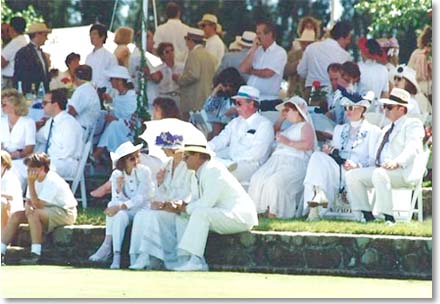
|
| We recognize some veteran croquet players in the background watching the court at Sonoma-Cutrer. So we guess from the indifference of the socialites that it's the finals of the Sonoma-Cutrer World Championship, played as Association Croquet, probably in the early nineties. |
The English still lead the way, with restraint
Coercion of various sorts has been briefly considered, one assumes, in all the board rooms, but soon abandoned. The Croquet Association's Chairman of Marketing, Dr. Eugene Chang, writes, " We commission an independent survey of croquet players every five years, with the last one in 2017.... The author of the survey points out that 34% of players surveyed are AC players [which means that] GC players are outnumbering AC players by up to 2:1, compared to 50:50 in 2012."
And yet, most people who take up croquet in England these days seen to regard it as the kind of "social" activity that Belgium has publicized over the last decade to promote "the sociable sport." It's exactly what some of the English characterize with contempt as "pat and chat" croquet.
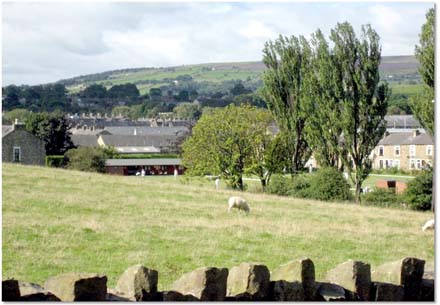
|
| This gorgeous photo of England's Pendle Club puts the sport in proper perspective. The sheep seem perfectly content, and we can't tell whether the players on the valley floor are patting and chatting. |
James Hawkins, in creating and populating the Liverpool Croquet Club, tried at first to recruit new players via AC, but now says, "I've no problem with the two formats of the game, having played both at championship level. I prefer AC, but some of my colleagues prefer GC.
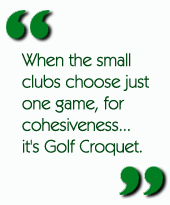 "The problem is practical. "The two codes can't be played on the same court at the same time. With a fledgling club and a limited amount of space (I have two full sized courts), there's not room for me to have AC and GC played at the same time. That's extremely unhealthy for establishing a cohesive club.
"The problem is practical. "The two codes can't be played on the same court at the same time. With a fledgling club and a limited amount of space (I have two full sized courts), there's not room for me to have AC and GC played at the same time. That's extremely unhealthy for establishing a cohesive club.
"There's a critical mass for a sustainable club--around, say, ten--but it's ten for AC and ten for GC. That doesn't make one club of 20 players; it's two clubs of ten, with neither having access to the facilities for the other half of the week. That in turn restricts the times you can recruit or coach or play league matches for each version.
"Larger and better established clubs don't encounter the problem to the same extent, but there are small clubs which have evolved towards offering just one format. That's becoming GC in many parts of the UK. Once the majority within a club move towards GC, we're starting to lose the infrastructure of AC both locally and regionally. Once a region loses its skill set of AC coaching, it will be difficult to get it back."

|
| These monks LOOK serious, but religion may be at the root of their apparent ennui. |
But our job here is not to assume anything. Let us first examine the facts in each country as objectively as we can, and try to come up with at least a path towards preserving the traditional game.
The South Africa bellwether
According to Susan Crole, long-time retiring secretary of South Africa's national association, Association Croquet has virtually vanished throughout most of the country, and many if not most clubs play Golf Croquet only. In the Johannesburg area, there are a few players of AC, as well as in the extreme south, on the shores of the Indian Ocean. She writes, " Somerset West is the biggest club in the country where I live, with four courts and a relatively high membership, but only Judith Hanekom and William Louw play Association.
"When the Brits come over in February for the Western Province annual tournament there is a reasonable Association entry and other Golf Croquet players get excited and think they should start it up but always fizzles out. When I first joined the club 20 years ago there were two afternoons set aside for Association."
But now, she says, no days are set aside for AC.
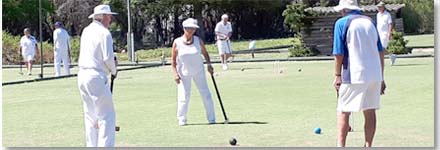
|
| South Africa's Somerset West Croquet Club west of Capetown is the biggest club in South Africa. The game played mostly by members on all four courts is Golf Croquet, double-banked, as in this photo. |
Responding to a request for comment, South Africa native and multiple world champion Reg Bamford wrote to Bob Alman in September: "I'm slightly out of the loop, as I've been resident in the UK since 1992. But I'd corroborate what Susan has to say: I only know of three South Africa players who still play AC (Carole Knox, William Louw and Judith Downton). Everyone else plays GC!!"
Among William Louw's explanations of the titanic shift in game preference was a factor that applies universally: "It is not easy to take leave from work to play Association (you need a week for most South Africa tournaments), but for Golf Croquet you can use a weekend." And that's only if you can pry them away from their hand-held devices and social media to pay attention.
With this truly radical shift in a relatively small croquet population, is South Africa a bellwether for the future of the sport of croquet worldwide?
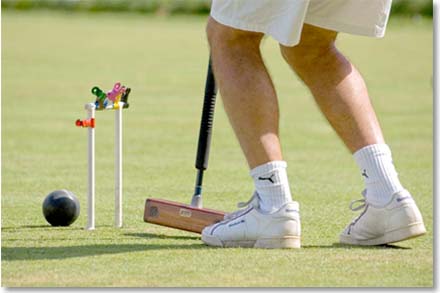
|
| With all those clips, this game looks dauntingly serious, whatever the code. |
New Zealand has completed the best multi-year study
Croquet New Zealand has announced a "strategic plan for 2016-2020," backed with statistics dating back five years or more which show a radical decline at club level in the percentage of players who even attempt to learn Association Croquet. According to Executive Director Jake Inwood, "CNZ does not have a policy of what a club must offer. While we encourage clubs to be inclusive and try to ensure both codes are supported at the National level, it is the clubs / players choice which game they play." After deliberation, all the national associations can do responsibly is "encourage" and "support."
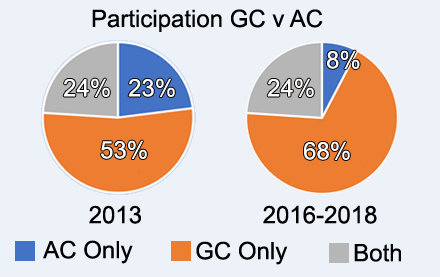
|
Referring to a series of pie-charts in the published Croquet New Zealand report, Jake continues, "It would appear that 23% represents the percentage of members who played AC only in 2013. Between 2016-18, 8% of the survey respondents had played AC only, while 24% had played both AC and GC." These numbers are horrifying to many.
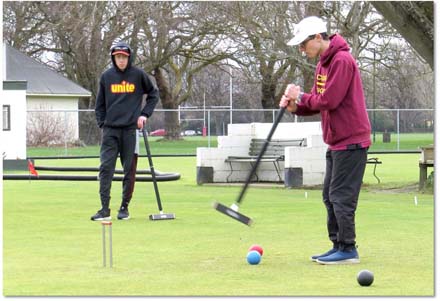
|
| Teen competing in New Zealand's Secondary Schools Championship at the United club display advanced skills in Golf Croquet, and some are becoming interested in Association Croquet as well. The program is organized and run by top player Greg Bryant. |
John Prince, legendary as a top-ranked player in New Zealand and the first in the world to complete a sextuple in competition, quoted from a CNZ article "A New AC Initiative," that [AC] percentage is way down from the 47 percent who played AC only in 2013. Prince is disturbed about the trends, but cautiously optimistic: " Our young players have stated that they like competing against their peers, and I have said repeatedly that we should play the U21 [under 21] tournament with both codes, and finally it has been suggested that this may happen in 2020."
 New Zealand has sustained a vigorous development program through the "high school" system for the last decade which has resulted in some significant teenage victories in WCF title events. (Croquet World online reported this in detail in our 2015 article.)
New Zealand has sustained a vigorous development program through the "high school" system for the last decade which has resulted in some significant teenage victories in WCF title events. (Croquet World online reported this in detail in our 2015 article.)
Croquet New Zealand's meticulously conducted 2018 Player Survey addresses all the elements of the global crisis as support for their Strategic Plan. The final recommendations will have to line up with their bottom-line viability, measured in numbers of dollars and players.
The New Zealand Survey in 2018 confirms in raw statistics what is already known in every country: Golf Croquet really IS "taking over" the lawns and the clubs around the world. Golf Croquet really does have a much larger participation base already than Association Croquet, and the Golf Croquet advantage is growing exponentially, as older people who play AC die off and new players--by a huge margin--prefer Golf Croquet. Only 32% of the questionnaire respondents to CNZ's elaborate survey played Association Croquet within "the last two years," compared to 92% having played Golf Croquet over that same period.
From 2013 to 2018, there was a huge jump in the percentage of players who played Golf Croquet ONLY: from eight percent in 2013 to 23 percent in 2018.
 The survey is careful to emphasize--as all associations must--that "Golf Croquet is an essential part of Croquet in New Zealand and currently a main contributor to the financial sustainability of Croquet New Zealand. Golf Croquet should not be neglected in any attempt to increase the participation in Association Croquet."
The survey is careful to emphasize--as all associations must--that "Golf Croquet is an essential part of Croquet in New Zealand and currently a main contributor to the financial sustainability of Croquet New Zealand. Golf Croquet should not be neglected in any attempt to increase the participation in Association Croquet."
The pie charts show that the main reason Golf Croquet players gave for not taking up Association Croquet was that they were "happy playing Golf Croquet; the next largest percentage cited "not enough time." The inference can hardly be avoided: If we want our clubs and associations to grow and prosper, we must include Golf Croquet.
Australia confirms the pattern
Australia's states control the action in that continent, with the ACA having a limited role in what actually happens in local clubs. Most clubs in Australia play mostly Golf Croquet, and when a new Golf Croquet player takes an interest in Association Croquet, he or she gets much praise and encouragement from AC veteran players.
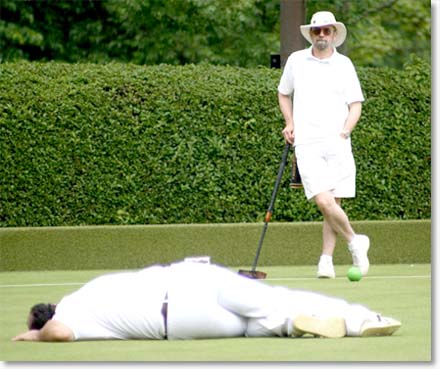
|
| We'd guess this isn't just a nap before tea-time, judging from the waiting posture of the guy with the green ball. |
Australia has more croquet players than any other country in the world. Arguably the sportiest nation on the globe, Australia has long ago "legitimized" all forms of the game with little balls that are struck to pass through hoops as "Mallet Sports."
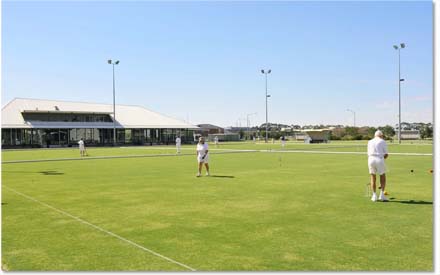
|
| Australia's Victoria Centre, near Melbourne, encourages the play of all Mallet Sports, as promoted by the Australia Croquet Association. |
At the club with the most court capacity and the one most often used for major competitions, the Victoria Centre, all forms of the game are played, allowed and encouraged equally--including Ricochet, Gateball, and seven other recognized forms of the sport.
With three main games, the USCA appears unperturbed
The US national association was created in the late seventies with Jack Osborn's American Rules, which is still, by a huge margin, the predominant form of "advanced croquet" played in America and at least as complex and confusing to novices as AC. In 2019, there are few signs of extreme alarm over the decline in play of either Association Croquet or American Rules. And this is despite the same statistical trends towards Golf Croquet fomenting extreme alarm among traditionalists.
Johnny Mitchell, as a former president of the USCA, is today surely the most experienced USCA staff "Tournament Manager." He describes Golf Croquet as a boon to the sport The properly objective president of the USCA, Sara Low, agrees that the USCA should not have a "position" on what local clubs do. (Egypt doesn't have a position on it either, because they never played Association Croquet at all.)
However, the membership club at the National Croquet Center-like many US clubs-has decided to "encourage" the play of American Rules croquet in various non-coercive ways, including lessons in American Rules promoted to NCC club members.
Which of these three is the "wrong" game?
Perhaps it's useful to acknowledge that the USCA has already gone through a "wrong game" panic more than a quarter century ago, and the worry then was that Association Croquet would replace American Rules. That hasn't happened. In my observation, generally only the top rank of players compete in Association Croquet in the US, or those aspiring to international competition.
Today moves are under way at the USCA to "equalize" the three games by having separate Grand Prix contests for each of them, throughout the year. (The standard Grand Prix, combining results from all forms of the game to produce an annual "Player of the year" has declined in recent years from about 1000 players to close to 800--indicating to some that a lower percentage of USCA players travel to play in sanctioned tournaments, because they are Golf Croquet players.)
The enormous growth of Golf Croquet in the Western highlands of North Carolina more than a decade ago, largely orchestrated by USCA president Gene Young, demonstrated to everyone the powerful appeal of Golf Croquet, in ideal circumstances. (See the Croquet World article "Country Club Croquet spreading like wildflowers in the Carolina mountains". ) The country clubs are close together and about 12 of them regularly regularly stage team competitions. But with pitifully few exceptions, they all play Golf Croquet.
Notable exceptions do exist: clubs that buck the trend towards Golf Croquet. Johnny Osborn, long-time pro at Mar-a-Lago, reports an exceptional local club culture which still vastly prefers American Rules: "A couple decades ago (plus)" he wrote to me, "Mar-a-Lago started with the focus on American Rules. Throughout my stint there I have tried to promote Golf Croquet, and that's the version I offer to members out there for the first time.
"But with a club so embedded with American Rules, I almost have to slide them into that version to keep a unified collective. I have Golf Croquet tournaments on the schedule, which are usually canceled due to lack of interest. On the other hand, Golf Croquet becomes so valuable when family members or party situations arise. Golf Croquet just doesn't stick with the active players."
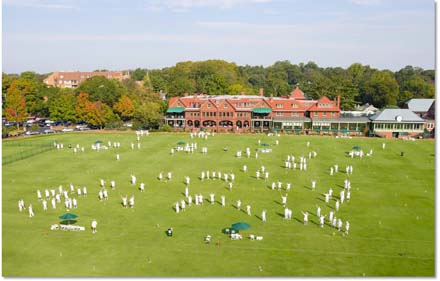
|
| At one time, near the turn of the century, Pennsylvania's Merion Cricket Club (above) created the biggest expanse for serious games in America by grooming their terraced cricket courts for croquet. At a distance, one can't be sure how serious the game is. At Mission Hills (below), in Southern California, they play mostly Golf Croquet now, but still host major events in Association and American Rules. |
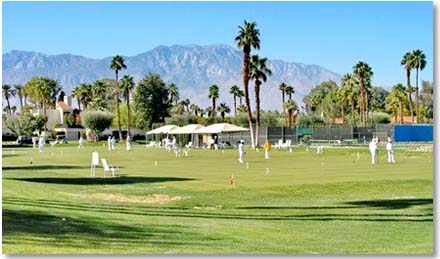
|
At the other end of the spectrum, the case of the Pasadena Club is more typical. It's the most popular club now in the Los Angeles area, and it's hard to find an AC game there, ever. But Rhys Thomas is unperturbed: "I don't see a 'crisis' of any kind. Golf Croquet is clearly growing the sport beyond the traditional confines of Association Croquet and American Rules. On the one hand, we should be thankful for that; on the other, it may turn out to be like finding a favorite little-known restaurant only to have it ruined by a great review that makes it much too well-known and brings in the hordes and hour-long waits for a table.
"The solution, to me, at least for larger clubs (three lawns or more), is to have dedicated AC/AR lawn(s) and separate dedicated GC lawn(s). There is a precedent, in the once adversarial relationship between Lawn Bowls and Croquet, the latter being the unwanted step-child. Time eventually healed that rift, at least in places such as Beverly Hills, Pasadena and Oakland, where the bowlers, having seen their ranks diminished, finally accepted the Croqueteers, if only to boost membership and funding in their own flagging clubs. (A few even crossed over, from one sport to the other.)
"I like all three codes, preferring none over another. I'll also point out that the best croquet players in the world play AC and GC and enjoy both. And here in America, the best players play all three versions.
"So what's the big deal? It's really about court time, isn't it? It's no mystery that AC players are feeling the nudge. I don't think we've come to a two (or three) sport situation. We all still play croquet, much like pool players have 8-ball, 9-ball, straight pool and snooker. My position, simply stated, echos the sage words of the late Rodney King: 'Can't we all just get along?'
The statistics make the trend look inexorable
But Mike Orgill of Northern California has a much different viewpoint, as a long-time president of Sonoma-Cutrer: "Erv Peterson and I once ran a Santa Rosa city park and rec group for AC. About 400 people came out in a year. One person joined the club and continued playing (Phil Arnold).
"The AC players are like the wedding guest in the book of Matthew who did not wear the wedding garment and was cast out. Or to use another simile, GC is the cuckoo bird that took over the nests already established by the AC birds.
"People--especially older people, the people most apt to start playing croquet, don't have the patience to learn croquet shots and strategy at places like Sonoma-Cutrer and Meadowood. Anyone can watch and understand GC quickly and follow the games. Jerry Stark never taught AC at Meadowood. It was too time consuming and wasn't profitable. "In the Bay Area, everybody who joins the clubs are elderly, have diminished eye-hand coordination, don't want to devote the time to practice, and have no patience or time to practice the AC game. AC isn't interactive, GC is. Most people don't have the patience to sit down and watch somebody beat their brains out. Either this is a flaw in AC and AR or it's a flaw in human nature. People don't have the patience to learn croquet shots.
 "I have up close and personal experience about this since I'm still doing croquet groups for Sonoma-Cutrer. I see the attitudes, the psychology, the resistances and the same old questions all the time. Thousands have played GC at Meadowood, and not one AC player has come out of there. We've had at least 50 paid GC groups at Sonoma-Cutrer over the past two years and no more than five have joined our club, and not one of those five has any interest in playing AC.
"I have up close and personal experience about this since I'm still doing croquet groups for Sonoma-Cutrer. I see the attitudes, the psychology, the resistances and the same old questions all the time. Thousands have played GC at Meadowood, and not one AC player has come out of there. We've had at least 50 paid GC groups at Sonoma-Cutrer over the past two years and no more than five have joined our club, and not one of those five has any interest in playing AC.
Orgill gloomily concludes: "If we're lucky the GCers will allow the ACers to play occasionally."
Yet there is one place where traditional croquet survives and is played often, with great gusto: It's "backyard croquet," the nine-hoop game that started the croquet craze in garden parties all over the English-speaking world in the middle of the 19th Century. Could it be that we are headed back to the future, on bumpy turf but with the two-ball croquet strokes and bonus shots--and some of the tactics--we veteran players have grown to love?
|
SOSIN'S "INNOVATIONS" POINT TO If Howard Sosin is the smartest man in croquet, WCF Secretary-General and championship player Stephen Mulliner is the second smartest. Mulliner has been among the invitees to both Innovations events at the National Croquet Center in West Palm Beach-- along with a half-dozen other top AC players, and they all had a great time. They not only played Sosin's games, but also conferred frequently with him on "good ideas" that would improve the rules, then tested them in play. Sosin's games elicit both careful thought and meticulous play in each turn--which keeps the thinking person engaged constantly, saving him or her (and the spectators) from the boredom of perfect breaks and triple-peels. Here's part of what Mulliner said about the 2019 event, at the NCC in West Palm Beach: "This is much more interesting than plodding round on a routine 4-ball break or even a triple. With the adjustments made at the 2019 event, I see Peel Croquet as completing a set of AC versions suitable for all playing conditions." CROQUET WORLD covered the 2019 event, and the links at the top of that article will take you to Sosin's constantly revised and updated collection of innovative games for players at all levels . Two-Shot croquet, at the other end of the spectrum, can be played by novices who just learned conventional Golf Croquet--or even as the "introductory" game. Can Sosin's games save the traditional sport of croquet at the club level? Maybe....but only if people learn how to play them. |
|
COURTSPACE, DEMOGRAPHICS, AND PLAYING EXPERTISE COULD ALL BE UNITED IN ONE PATH TO THE FUTURE
You could urge your national association (or, failing that, your club) to DESTIGMATIZE both court sizes and game codes--GC or AC or AR (American Rules). This will enable a club to create more "space" for the members, pegged to their handicaps: players handicapped four or fewer could have full-size courts, which they need to have a good game in either GC or AC; players handicapped at five or above could use half-courts for both GC and AC, when space is needed for member play.
Most clubs could increase their available playing space by a significant percentage, allowing for more lawn space, more play, and less double-banking. (The court size apportionment would also incentivise players to improve their games. In the opinion of many, including myself, learning any form of mallet sports on reduced-size courts is workable and maybe even preferable--and the games are fun.) All the above are for your "regular members," of course. But in addition: If the club has a useable "social space" adjacent to the lawns, inaugurate a YOUTH GROUP for late afternoon/early evening play which combines games with liquor and socializing, and here's the vital part: Protect this group from old people; One (and only one) old person can be on the lawns and available (note the word: "available"!) to offer instruction or just to answer questions from young people socially engaged in an activity resembling some form of croquet.
Remind this old person that the young people are mostly interested at this point in engaging with each other either for "hooking up" or for making a connections related to their work enterprises. Begin with a "free event" with liquor available for purchase: Or allow them to bring their own liquor, and sell them cola or water for five bucks a shot--something useful your one allowed old person could do! Then as the group becomes established, offer a paid "special membership" to these "corporate-age" people for, in addition to the evening play, one weekend period of play--exclusively for their group, not including any old people at all! Notice that any beginning group will be entirely willing to play on courts the veterans regard as small--because it's a more intimate experience for making their interpersonal pitch--whatever it is. Over time, the outsize influence of such a group will begin to alter the public image of croquet, locally, as "something old people do." It will begin ever so slowly to transform croquet as well into "a cool activity for young people." Upon the obvious success of this enterprise, a long-range vision would include the realization (via your publicity) that croquet clubs for young people are ideal and also profitable as an alternative to the often sleazy pick-up joint. It's okay for you to be salaried as a consultant on these projects! But what about the form of the game--the subject of this entire article? The answer is that seducing a lot of young people starts to alter the public image of the game, at least locally. It's true that very few of them will take an interest in contact croquet. But by spreading a wide net, you will catch more of the most desired species, hopelessly fascinated by the challenge of Association Croquet. Both of these ideas have been successfully actualized by the organizing manager at the National Croquet Center in the early 2000's, and both destroyed by his immediate successors for perfectly good and sensible and, as it turned out, disastrous reasons. |
Thanks to Mike Orgill, Rhys Thomas, and James Hawkins for help with this article--all of them distinguished in various roles in the sport of croquet. Mike was long-time president of Sonoma-Cutrer and still manages corporate groups there. Rhys has performed many roles in the USCA and the WCF and has played on US international teams. James Hawkins was long-time editor of the English Croquet Gazette and is the founder and guiding spirit of the Liverpool Croquet Club.
